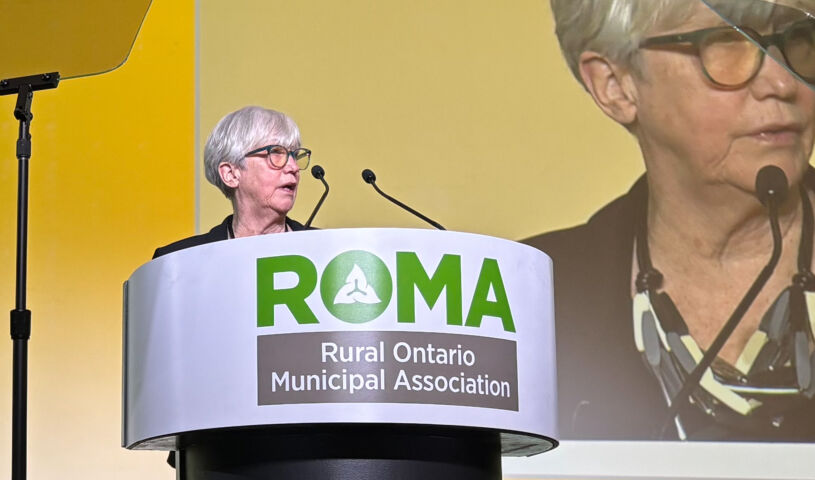ROMA 2024 offered up enthusiasm, plenty of conversations
 The ROMA 2024 conference saw delegates discuss a number of important topics, but their points were all backed up by what the organization’s chair, Robin Jones, calls a fact-based approach. Photo: Megan Abraham
The ROMA 2024 conference saw delegates discuss a number of important topics, but their points were all backed up by what the organization’s chair, Robin Jones, calls a fact-based approach. Photo: Megan Abraham
Rural communities in Ontario are struggling to cope with the impacts of an underfunded health system. This isn’t hyperbole or political spin, but backed up by facts, according to the board chair of the Rural Ontario Municipal Association (ROMA).
Robin Jones, who is also the mayor of Village of Westport, said the situation is detailed in a recent report, Fill the Gaps Closer to Home. The report was unveiled at ROMA’s 2024 conference, last month, in Toronto.
The call for greater provincial support for Ontario’s health care system is nothing new. But Jones said this new report, and the conversations it is creating, is moving the needle on health care reform.
“Are we breaking through? Somewhat. But when we can give that sort of data … then I hope they’re open then to discussions on what are some of the solutions,” Jones said. “We’ve got lots of suggestions in the paper of what we can do in the here and now. We need consistent messaging that’s data driven. And that’s what this year’s report is all about, data. And so it’s hard to refute that.”
Filling the Gaps for Health Care
The report’s data is troubling. An estimated 525,000 rural residents are lacking a primary care provider. In both 2022 and 2023, there were more than 600 temporary Emergency Department closures in rural Ontario.
Jones also pointed out that the research shows rural Ontarians are losing primary care providers at a rate of 12 per cent per year. This is four times faster than what is happening to people in urban centres.
Rural communities are also facing a lack of primary care providers and acute shortages in health care workers and recruitment. Jones also said the travel time for rural Ontarians to access these health care can be significant.
That said, the paper does point to 22 potential solutions that Jones said could make a real difference – eventually.
“This isn’t going to go away in the short term,” Jones said. “I guess it’s a marathon as opposed to a sprint. But there are some things in the sprint category that we can do.”
An Evidence-Based Approach
Mark Wilson, a city councillor in Temiskaming Shores, is also a proponent of ROMA’s evidence-based approach.
Wilson was first elected to the board last year, which was also his first year on Temiskaming Shores council. As he puts it, he’s admittedly “starting late in the game as a councillor.”
As Wilson gets used to not only his council seat, but his role on the ROMA board, he is quick to laud the group’s commitment to an evidence-based approach.
Having met and chatted with many colleagues over the past couple years, Wilson said he has learned a lot. His most important lesson could be that rural communities have pretty much every problem that urban centers do, but with many others as well.
He is also learning that while some issues don’t always gain the attention of the other orders of government, that stereotypical perspective is changing. Wilson said he believes rural issues are being heard and are being addressed. But the question becomes whether the attention is spurring any real results.
Is this attention resulting in what rural municipalities want all the time? Probably not, he admits. But when it does, Wilson said it is often due to effectively using data.
“The key is to be informed. To be able to put the numbers in front of the government. And that’s really the only way that you make some effective change,” Wilson said. “That’s certainly what we’re trying to do with ROMA. We’ve got some excellent consultants and AMO staff that are just super as far as trying to help us with moving some of these issues forward.”
Topics of Rural Concern
As important as access to health care is for ROMA, it was far from the only topic of discussion at the conference.
Rural connectivity, housing, and gender-based violence were only a few of issues debated and discussed. These are also some of the areas where Jones said she can see real progress being made.
As important as the conversations were, it was also essential they took place in front of an enthusiastic crowd.
Jones, who is in her third year as ROMA chair, said the organization “nailed it” with the 2023 event. Some 1,900 people (OK, Jones’ love for specifics puts the real number at 1,896) attended the conference. Delegates filled the plenary sessions, the concurrent workshops, minister forums, and the vendor booths.
The 2022 event was ROMA’s first “post-COVID” live presentation. Jones said last year’s event “exploded” possibly due to people’s frustration with having to use the virtual approach the previous couple of years. But the “enthusiastic turnout” for 2023 tells Jones that ROMA is getting things “mostly right” for its members.
“The advocacy we do with the government, the policy work that we have been doing the last few years, that turnout tells me that, again, we’re getting it pretty well right,” Jones said. “And the expectation is that ROMA will continue to make a difference in the lives of people who live in rural Ontario.”
Better Funding for Infrastructure
Wilson agreed the turnout to the conference reflects the strength of ROMA’s advocacy efforts. While also lauding the work being done around rural homelessness and health care, Jones said he had many discussions around topics that seem less in the media spotlight.
Access to French language services, particularly in northeastern Ontario where there is a significant Francophone population, is a real concern. Transportation, Wilson said, is always a huge issue. This is particularly true in rural and northern parts of the province. Another concern is access to labour. Lacking sufficient access to labour impacts a variety of issues. These included everything from housing availability to economic development.
Another topic of conversation was infrastructure. Wilson said the call to build more housing and provide support for local contractors to build that housing means that municipal infrastructure gaps must be addressed.
Jones acknowledges that Ontario has announced a $200 million water wastewater program. But this number raises the question of whether that funding level is enough. And while he didn’t want to be too blunt, he did say that funding level is “pocket change,” which is a concern to many of his rural colleagues.
“It’s right across the country. We’ve had government at both [federal and provincial] levels for many years that have not invested in those types of systems,” Jones said. “How do we keep on top of that when we’re just running around fixing things? It is about the investment. If we keep trying to fix things, it’s just so inefficient compared to developing a good system in the first place.” MW
✯ Municipal World Executive and Essentials Plus Members: You might also be interested in Sean’s other article: Rural broadband access remains an issue, pandemic or not.
Sean Meyer is Digital Content Editor for Municipal World.
Related resource materials:


